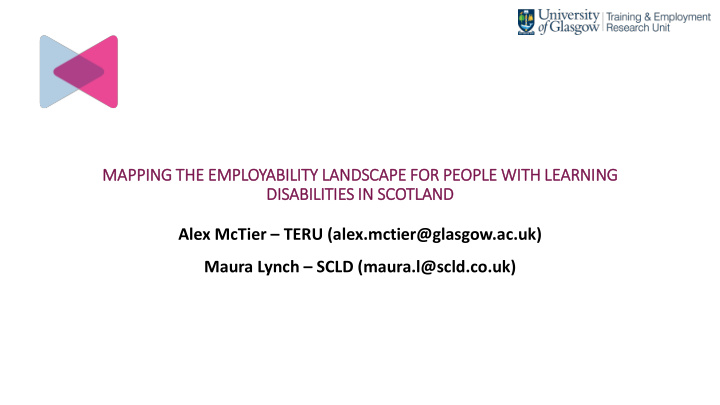



MAPPING THE EMPLOYABILITY LA LANDSCAPE FOR PEOPLE WIT ITH LE LEARNING DI DISABILITIES IN IN SCOTLAND Alex McTier – TERU (alex.mctier@glasgow.ac.uk) Maura Lynch – SCLD (maura.l@scld.co.uk)
Introduction • Research responds to ‘The keys to life’ – Scotland’s learning disability strategy. Key priority under Strategic Outcome 4 – Active Citizenship is: • ‘ Facilitate innovative social connectedness and employment opportunities for people with learning disabilities’ • Research aims to: • Understand scale and effectiveness of employability support for people with learning disabilities in Scotland • Make recommendations on how support can be enhanced .
Methodology • Desk-based analysis of statistical data and research literature • Mapping of funders and providers of targeted employability support services • 27 case studies with individuals • Additional case studies with employers and models of support
Scoping Out the Challenge: Employment Rates of People with Learning Disability
Scoping Out the Challenge • Low employment rate – but this is only part of the challenge • 65% to 70% working less than 16 hours per week • 29% in non-open / sheltered employment • Distinction should be made between: • Real, sustainable employment – employed in open labour market, 16+ hours/week, National Living Wage as minimum, and opportunities to develop and progress • Part-time, sheltered employment – less than 16 hours/week, sheltered employment, and acts as substitute for day care opportunity
Scoping Out the Challenge • Difficult to understand full level of demand for employability services among people with learning disability in Scotland. Issues include: • Variations in how organisations define learning disability • Reliance on self-disclosure • Limited recording of learning disability in monitoring systems • However: • By applying 4% of Scotland’s school pupils who have learning disability or are on autistic spectrum to adult population… • …there could be as high as 125,000-150,000 out-of-work adults with a learning disability in Scotland
Potential Demand for Services
Factors Impacting on Employment Levels • Individuals want to work in rewarding and sustainable jobs but need to challenge and overcome low expectations held by parents, teachers, employers, etc. • Key features in employment journey of people with learning disability are: • On leaving school, pathway is typically college (52% of school leavers with learning disability) or unemployment (16% of school leavers) • When in college , ‘cycling’ between different courses viewed as common scenario • When looking for work, need to challenge both employer and employee preconceptions of what people with learning disability can do
Societal Factors – The Education System 2
Views from Individual Case Studies • Strong aspirations to work • Real diversity in hours currently working • Some young people displaying varied career paths, while older workers / volunteers can become ‘stuck’ • Instances of previous negative experiences of the workplace • Variable levels of employability support received but highlighted importance of long-term in-work support • Benefits system impacting on working hours • Should not overlook role played by family members
Mapping of Services • Mapping gathered data on mainstream provision, Supported Employment, and other targeted provision (including Project SEARCH) • Key finding is that landscape is complex, fragmented and seemingly under- resourced • No agreed definition of learning disabilities • Very limited statistical base in terms of: setting national benchmark of demand; understanding people’s employment and learning journeys; and effectiveness of employability services • No consistency of offer across Scotland’s local authority areas and no clear source of information about what is available
Employability Provision – Targeted Provision Outcomes
Asks of All Learning Disability Partners • Substantially improve recording and reporting of learning disabilities data • Establish more effective joined-up employment pathways • Double employment outcome rates for people with a learning disability to 50% over 5-year period • Secure additional resources for learning disability employability services
Asks of Scottish Government • Give greater priority to employability and employment of people with learning disability • Renewed promotion of Supported Employment Framework • Set Scotland’s employers target of 4% of employees to be people with learning disability
Asks of Local Authorities • Develop directories of employability services for people with a learning disability • Establish Supported Employment Services in all local authority areas
Asks of Skills Development Scotland • Collect and report learning disability data on people accessing MAs, national programmes and employment • Embed learning disability good practice in its contracted provision with providers of SDS programmes promoting the Supported Employment Framework as best practice • Set higher targets for providers working with people with a learning disability
Asks of Scottish Funding Council and Scotland’s Colleges • Greater focus on progression into real, sustainable employment. This may require more developed joint working with employers so that learners are developing skills in real workplaces not just college settings
Asks of SCLD • Continue to profile and promote learning disability employment and employability, its challenges, and the positive social and economic value of supporting people into real sustainable employment • Develop agreed definition of ‘learning disabilities’ so that funders, organisations and employers are clearer who is included and who is not
Asks of Employers • Increased employer commitment to recruiting people with a learning disability
We have identified 4 keys priorities • Overcome the low expectations held by parents, schools, colleges and employers. • Gather data more effectively, investing funding where people with a learning disability in Scotland secure both employment and support to develop in that job. • Use this data to invest in post-school funding into services that can deliver employment outcomes of 50% as detailed in the report. • Recruit and train Job Coaches that can support people with a learning disability into employment and throughout their careers. Recognising Job Coaching as a profession that has quality standards that are monitored nationally.
Recommend
More recommend